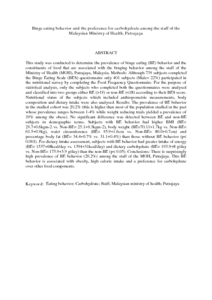Citation
Mohd Yusof, Barakatun Nisak and Abdul Rahim, Anilah
(2009)
Binge eating behavior and the preference for carbohydrate among the staff of the Malaysian Ministry of Health, Putrajaya.
Journal of the Asean Federation of Endocrine Societies, 24 (1).
ISSN 0857-1074; ESSN: 2308-118X
Abstract
This study was conducted to determine the prevalence of binge eating (BE) behavior and the constituents of food that are associated with the binging behavior among the staff of the Ministry of Health (MOH), Putrajaya, Malaysia. Methods: Although 738 subjects completed the Binge Eating Scale (BES) questionnaire only 401 subjects (Male= 22%) participated in the nutritional survey by completing the Food Frequency Questionnaire. For the purpose of statistical analysis, only the subjects who completed both the questionnaires were analysed and classified into two groups either BE (>18) or non-BE (<18) according to their BES score. Nutritional status of the subjects which included anthropometric measurements, body composition and dietary intake were also analysed. Results: The prevalence of BE behavior in the studied cohort was 20.2% (this is higher than most of the population studied in the past whose prevalence ranges between 1-4% while weight reducing trials yielded a prevalence of 19% among the obese). No significant difference was detected between BE and non-BE subjects in demographic terms. Subjects with BE behavior had higher BMI (BE= 28.7+0.6kgm-2 vs. Non-BE= 25.1+0.3kgm-2), body weight (BE=70.11+1.7kg vs. Non-BE= 61.5+0.9kg), waist circumference (BE= 85.9+1.6cm vs. Non-BE= 80.0+0.7cm) and percentage body fat (BE= 34.4+0.7% vs. 31.1+0.4%) than those without BE behavior (p< 0.001). For dietary intake assessment, subjects with BE behavior had greater intake of energy (BE= 1537+68kcal/day vs. 1394+31kcal/day) and dietary carbohydrate (BE= 193.9+8 g/day vs. Non-BE= 175.9+3.9 g/day) than the non-BE (p< 0.05). Conclusions: There is surprisingly high prevalence of BE behavior (20.2%) among the staff of the MOH, Putrajaya. This BE behavior is associated with obesity, high caloric intake and a preference for carbohydrate over other food components.
Download File
![[img]](http://psasir.upm.edu.my/13399/1.hassmallThumbnailVersion/Binge%20eating%20behavior%20and%20the%20preference%20for%20carbohydrate%20among%20the%20staff%20of%20the%20Malaysian%20Ministry%20of%20Health.pdf)  Preview |
|
PDF (Abstract)
Binge eating behavior and the preference for carbohydrate among the staff of the Malaysian Ministry of Health.pdf
Download (84kB)
| Preview
|
|
Additional Metadata
Actions (login required)
 |
View Item |

